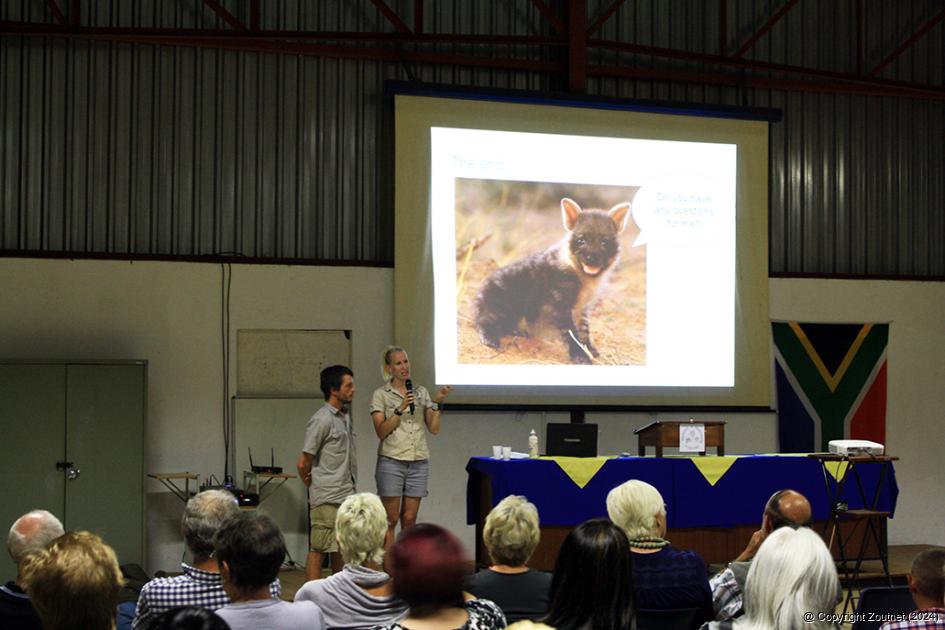

ADVERTISEMENT:

This year's Nature Night kicked off with a talk about brown hyena ecology by Katy Williams (right), a PhD student from Durham University, UK. Photo: Zach Mason.
Ghostly creatures and creepy crawlies not that scary anymore
Deep in the Soutpansberg Mountains, among its crags and cliffs, ghostly creatures are hiding.Scientists shared information on these ghostly creatures and other creepy crawlies of the Soutpansberg at the second annual Nature Night held on Friday, 29 January. The event was organised by the Durham University Primate and Predator Project (PPP) and was held at the Schoemansdal Environmental Centre (ECC).
A great deal of wildlife research and conservation work is happening in the region and Nature Night is a way for researchers to share their scientific findings with the community. This year, the focus was specifically on creatures that are normally avoided because they give the general populace the heebie-jeebies, including spiders, bats and hyenas. Researchers showed these species’ softer side and helped create more informed perceptions about them.
Almost 100 people attended the free event, including students from local schools and universities. “It is great to see so many in attendance and getting excited about conservation,” said Philip Faure, the PPP Community Engagement Officer and event organiser.
The evening kicked off with a talk about brown hyena ecology by Katy Williams, a PhD student from Durham University in the United Kingdom. The brown hyena is often misrepresented and feared, and this is partially because of its elusive nature. “There is still little known about the hyena locally, and some farmers believe that they are a pest,” explained Williams. Because hyenas are solitary and nocturnal foragers, some inhabitants of the Soutpansberg are still not aware of their presence in the mountains, hence some interviewees in Williams’ study refer to them as ghosts.
Williams has been photographing these ‘ghosts’ with camera traps. Data from an array of 80 camera traps in the western Soutpansberg mountains has enabled her to estimate the population density at between 2.5 and 3.5 brown hyenas per 100km². Through a second camera-trapping survey, she found that brown hyenas are widely dispersed in northern Limpopo. Avoiding high human activity is one of the key factors influencing the areas that brown hyenas occupy, suggesting they are as scared of us as we might be of them.
Two guest speakers from the University of Venda, both dedicated scholars in their fields, managed to elicit positive oohs and aahs from the audience about notoriously feared spiders and bats.
Dr Stefan Foord, who has more than 15 years experience of invertebrate inventories and field work, enlightened the audience with information about the extraordinary diversity of spiders in the Soutpansberg. Of the 1 230 spider species in the Savanna Biome, more than 600 are found in the Vhembe Biosphere Reserve. Many of these species are only found in this area - 366 species are endemics and 322 are near endemics. Dr Foord’s talk shared spiders’ beauty, clever survival mechanisms and ecosystem services. The majority of spider species pose no harm to humans. Despite common beliefs, only three types of spider can be harmful to humans in South Africa, namely the button spiders, sac spiders and violin spiders.
The evening concluded with a fascinating talk by Professor Peter Taylor, an expert on bats. Bats are often regarded as vermin. “Bats provide valuable ecosystem services such as pollination, seed dispersal, and pest control and they act as bio-indicators,” said Taylor. He is currently working with farmers in the area to promote the use of bats as pest control agents, and is supervising two PhD students conducting research on the pest control services provided by bats in macadamia orchards.
As in the case of spiders, the Soutpansberg is a bat hotspot in South Africa. In southern Africa, 116 species of bat occur and almost 40 of these species are found in the Soutpansberg Mountains. Taylor explained that bats are experiencing a global population decline, due to various factors, such as white-nose syndrome and wind farm turbines.
The message from all the speakers was that the Soutpansberg and the surrounding Vhembe Biosphere Reserve is a crucial area for wildlife. It is a biodiversity hotspot and home to numerous species that occur here and nowhere else. Unfortunately, many of these species are in conflict with humans, but everyone can play a part in preserving this area for wildlife to ensure their continued existence for our children’s enjoyment. And, thanks to this year’s Nature Night, some of the region’s nightmarish creatures are now a little friendlier.
News - Date: 12 February 2016

Recent Articles
-

Department shuts down Ziggy School
19 April 2024 By Thembi Siaga -

MMSEZ now also looking at nuclear power
19 April 2024 By Andries van Zyl -

Prophet Muritho's nightmare continues
19 April 2024 By Elmon Tshikhudo -

'When will the masterminds be arrested?'
19 April 2024 By Elmon Tshikhudo
Search for a story:

ADVERTISEMENT


Isabel Venter
Isabel joined the Zoutpansberger and Limpopo Mirror in 2009 as a reporter. She holds a BA Degree in Communication Sciences from the University of South Africa. Her beat is mainly crime and court reporting.
Email: [email protected]

ADVERTISEMENT:


